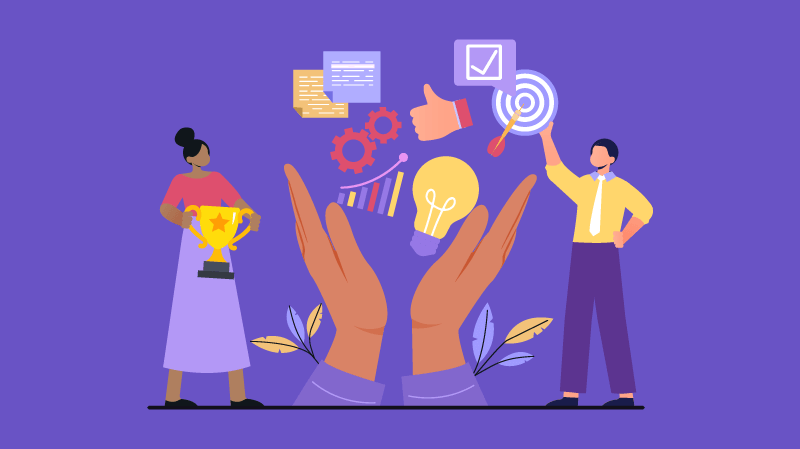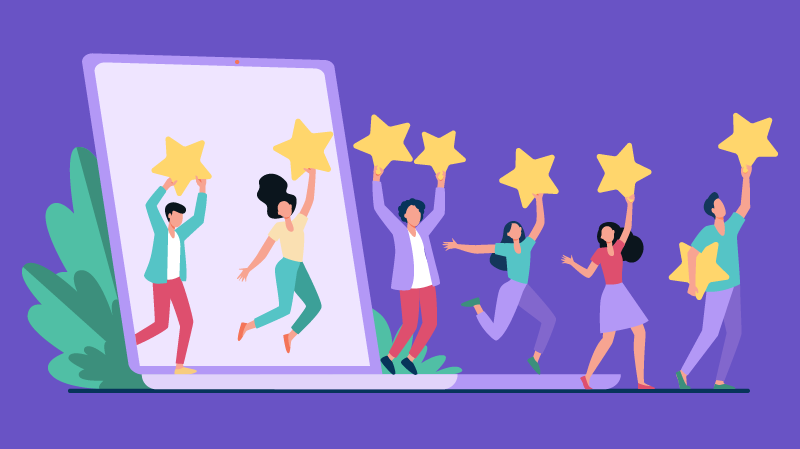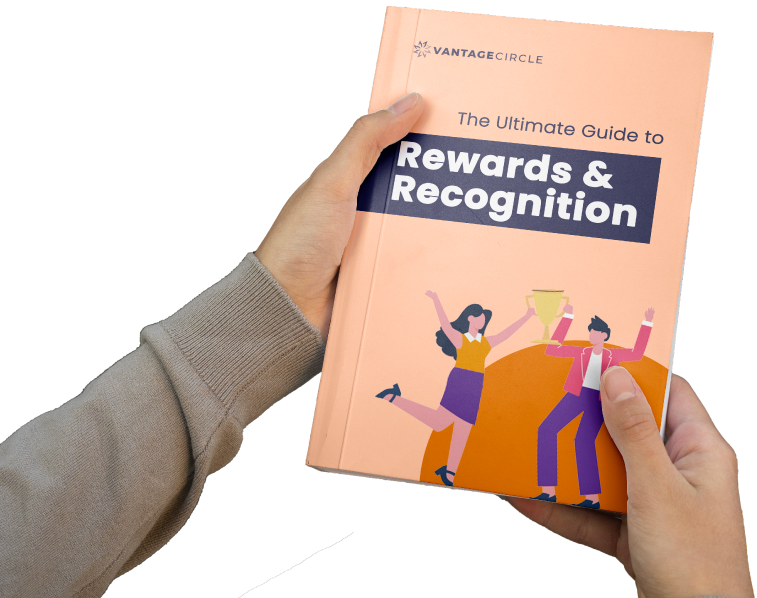Employee Recognition Badges for Digital Recognition: Ideas & Examples

A Global Employee Recognition and Wellness Platform
“Why We Remember Symbols More Than Words?”
Our brains are wired to respond to visuals. According to research from MIT, the human brain can process entire images in as little as 13 milliseconds1. That’s much faster than how we process language. This explains why symbols like emojis, icons, and yes—badges—stick with us longer than a Slack message that says “Good job!”
Behavioral science also supports this. The Dual Coding Theory suggests that information stored both as words and images (like a badge with a title) is easier to remember and more impactul2.
It may look small, but a badge packs the punch of a lasting memory.
What Are Employee Recognition Badges?
No clunky trophies collecting dust or kind words lost in a flood of Slack chats. Instead, you get a simple, meaningful badge—easy to spot, easy to share, and something you’ll actually remember. That’s the charm of employee recognition badges.
So, What Exactly Are They?
Employee recognition badges are digital tokens that celebrate specific achievements, behaviors, or values. Think of them as the modern-day equivalent of merit badges from scouts—only now, they live in your company’s recognition platform instead of a sash.
Unlike trophies (formal and one-off) or shoutouts (informal but fleeting), badges are repeatable, symbolic, and scalable. They bridge the gap between structured programs and spontaneous appreciation.
Where Do Badges Fit In?
Badges shine in both formal and informal recognition systems:
Structured Programs: Earn a “Customer Hero” badge every time someone hits a service milestone.
Peer-to-Peer Praise: Send a “Team Spirit” badge to a colleague who saved your Monday.
A Gallup study found that employees who feel recognized are 4x more likely to be engaged and 5x more likely to stay at their job1—badges make that recognition timely and tangible.
The Evolution of Recognition
From physical to digital: a quick timeline
- Plaques & Trophies (1980s–1990s): Formal, expensive, and mostly top-down
- Gift Cards & Perks (2000s): Transactional but more flexible
- Digital Badges (2010s–Now): Social, symbolic, and easily shared
Badges combine the personalization of a compliment with the visibility of an award, all while keeping things light, modern, and scalable.
Types of Recognition Badges
Not all recognition looks the same—and that’s a good thing. The best badge programs mix meaning with variety, giving teams different ways to say, “You nailed it!” Whether it’s a shoutout for smashing goals or simply being a joy to work with, badges make it stick.
Here’s a quick rundown of the most popular types—and how they show up in real workplaces:
Performance-Based Badges
For those moments when someone goes above and beyond.
Use case: “Top Closer” for hitting sales targets or “Efficiency Expert” for streamlining a key process.
Great for goal-driven teams or quarterly award programs.
According to Certifier, recognizing top performance boosts engagement and encourages healthy competition1.
Core-Value Aligned Badges
Celebrate the behaviors that define your culture.
Use case: “Customer First” badge for someone who solved a client issue creatively, or “Own It” for taking initiative.
Perfect for reinforcing what your company stands for—daily.
Gallup reports that when recognition aligns with company values, employees are 3.6x more likely to feel emotionally connected to their work.
Milestone-Based Badges
Honor the big (and small) wins along the way.
Use case: “1-Year Legend” for work anniversaries or “Birthday Star” for personal milestones.
Helps employees feel seen beyond just their work.
Companies that celebrate milestones report lower turnover and higher morale1.
Peer-to-Peer Badges
Recognition that flows sideways, not just top-down.
Use case: “Team Player” for helping out a colleague or “Monday Saver” for fixing a last-minute issue.
Encourages a culture of everyday appreciation.
Peer recognition is 35% more likely to have a positive impact on financial results than manager-only recognition3.
Culture, Fun & Wellness Badges
The not-so-serious—but totally necessary—badges.
Use case: “Wellness Warrior” for someone who leads a yoga break, or “Vibe Keeper” for keeping spirits high.
These badges remind people that being themselves is part of the job too.
These types of recognition support psychological safety and inclusivity—two key drivers of retention1.
Startups vs. Enterprises: Same Game, Different Rules
Startups love fun, fast feedback—badges are often casual, quirky, and shared publicly on Slack or Teams.
Enterprises may lean on structured badge programs tied to performance reviews or HRIS systems.
Both can work—as long as the recognition feels real.
Digital Badges vs Digital Certificates
Badges and certificates may both live in your inbox—or on your LinkedIn profile—but they serve very different purposes. Think of it this way: badges are like high-fives, and certificates are more like diplomas.
What’s the Difference?
-
Digital Badges are small, visual tokens awarded for specific actions or behaviors. They’re informal, instant, and often peer-driven.
Example: “Team MVP” or “Wellness Champion.” -
Digital Certificates are formal recognitions tied to training, achievements, or compliance. Think structured learning and career development.
Example: “Certified Project Manager” or “Data Privacy Compliance Completed.”
While both are digital, badges are usually shared on internal platforms or social media, while certificates often come with a PDF, a credential ID, or even a verification link.
When to Use What?
| Use Case | Digital Badge | Digital Certificate |
|---|---|---|
| Peer-to-peer recognition | ✅ | ❌ |
| Celebrating soft skills | ✅ | ❌ |
| Completing a training module | ❌ | ✅ |
| Compliance or onboarding | ❌ | ✅ |
| Ongoing engagement | ✅ | ❌ |
| Formal career milestones | ❌ | ✅ |
Why It Matters
Mixing both creates a culture of continuous recognition. Badges drive day-to-day engagement, while certificates offer long-term validation of professional growth.
In fact, employees are 48%, more likely to stay with an organization that recognizes both skill development and day-to-day wins1.
Best Practices for Designing Meaningful Badges
A badge may be small, but done right, it can spark motivation, reinforce values, and even trigger dopamine (seriously!). Here’s how to make your badges not just pretty—but powerful.
1. Design for Clarity
Keep it simple. A badge should be instantly recognizable at a glance—whether it’s a star, lightning bolt, or handshake. Avoid clutter and make sure it scales well across devices. Pro tip: Use universally recognizable icons and stay consistent with your design system.
2. Use Color with Purpose
Colors aren’t just aesthetic—they feel a certain way.
- Gold = achievement
- Blue = trust and collaboration
- Green = growth and wellness
- Red = urgency or leadership
According to UX Collective, color-emotion mapping increases visual recall by 39%1.
3. Name It Like You Mean It
A badge called “Employee of the Month” is fine. But “Culture Champion” or “Innovation Ninja”? Way more engaging. Make names specific, value-driven, and a little fun—people are more likely to remember and share them.
4. Set Clear Award Criteria
Ambiguity kills meaning. Make sure each badge has a clear why—whether it’s tied to a behavior (“Helped 3+ teammates this month”) or outcome (“Completed 5 client projects”). Clarity makes recognition feel earned, not random.
5. Add a Dash of Gamification
Badges play into basic human psychology: we love collecting things.
- Create tiers or levels (e.g., “Mentor → Guide → Guru”)
- Show progress tracking to motivate ongoing effort
- Let people display badges publicly—in profiles or dashboards
A study by TalentLMS found that gamified elements increased employee motivation by 89%2.
Bonus UX Tip: Trigger Emotion
Use micro animations (like a sparkle or sound cue) when a badge is awarded. That small dopamine hit can boost positive reinforcement and deepen the emotional impact.
Meaningful badges don’t just reward action—they reinforce culture, boost morale, and keep employees coming back for more.
How to Launch a Badge-Based Recognition Program
You’ve got the badge ideas—now it’s time to roll them out in a way that feels exciting, not like another HR checklist. Here's a simple step-by-step to get your program off the ground and into your team's hearts (and Slack channels).
Step 1: Define the “Why”
Before designing anything, clarify your goals.
- Want to boost engagement?
- Reinforce values?
- Encourage learning or collaboration?
Clear goals = meaningful badges = better impact tracking.
Step 2: Map Your Badge Categories
Organize your badges into easy-to-understand categories:
- Performance (Top Closer, Productivity Pro)
- Culture/Values (Team Spirit, Ownership Champ)
- Milestones (Work Anniversaries, First Win)
- Wellness & Inclusion (Mindful Monday, Ally Badge)
Tip: Make sure every category ties back to a business or cultural goal.
Step 3: Design with Purpose
As shared earlier, focus on:
- Visual clarity
- Color-emotion alignment
- Clear names and criteria
Fun fact: 39% more recall when visuals use intentional color design.
Step 4: Roll It Out (Make It a Moment)
Get buy-in by making the launch feel like an event—not just another HR drop.
Sample Slack/Teams Announcement:
Say hello to our new Recognition Badges! Starting today, you can give (and earn!) badges for everything from team spirit to creative problem-solving. Head to [link] to explore the badges and start spreading the love
Let's celebrate the small wins—and the big ones too.
Sample Email Launch Copy:
Subject: Your Wins Deserve a Badge
We’re rolling out Recognition Badges—a new way to celebrate everyday awesomeness. Whether you’re a behind-the-scenes hero or a culture champion, there's a badge with your name on it. Start giving (and earning) badges on [Platform/Link]. Because great work should never go unnoticed.
Step 5: Integrate with Your Tools
Make it easy for people to engage—directly from where they already work:
- Slack/MS Teams: Set up badge bots or commands (/givebadge @Alex Collaboration Star)
- HRIS/Engagement Platforms: Sync with systems like BambooHR, Workday, or Vantage Circle for seamless recognition + reporting.
Companies with integrated recognition programs see a 31% lower voluntary turnover rate.
Step 6: Measure & Evolve
Track:
- Badge activity (who’s giving/receiving what)
- Engagement over time
- Impact on retention, culture scores, or team performance
Use feedback to refine categories, badge names, or criteria. Make it feel fresh and relevant.
A badge program isn't just about icons—it's about creating a culture of everyday appreciation. When done right, it builds community, boosts morale, and reminds people their work matters.
Employee Badge Examples & What They Represent
Badges aren’t just digital flair—they’re mini-stories of what your culture values most. Below are some powerful examples of recognition badges, each tied to a specific mindset, behavior, or moment that deserves the spotlight.
Innovation Champion
What it means: Celebrates creative thinkers who bring bold, new ideas to life.
Behaviors rewarded: Suggesting improvements, solving problems in new ways, leading process innovations.
“When I got the Innovation Champion badge, I felt like my ideas actually mattered—even if they were a little out there.” – Tanya, Product Team
Culture Carrier
What it means: Honors those who consistently embody company values. Behaviors rewarded: Demonstrating integrity, kindness, ownership, or other core values in action.
Employees recognized for values alignment are 3.6x more likely to feel emotionally connected to their workplace.
“This badge reminded me why I joined this company in the first place.” – Rahul, Sales
Growth Guru
What it means: For those always learning—and inspiring others to learn.
Behaviors rewarded: Completing certifications, mentoring peers, sharing knowledge. According to LinkedIn Learning, 94% of employees would stay longer at a company that invested in their career development.
Team MVP
What it means: Given to colleagues who consistently support and uplift others.
Behaviors rewarded: Cross-functional collaboration, stepping in to help, positive attitude.
“It felt amazing to get noticed just for showing up for my team.” – Aisha, Marketing
Inclusivity Ally
What it means: Recognizes employees who actively foster an inclusive and respectful environment.
Behaviors rewarded: Amplifying underrepresented voices, participating in DEI initiatives, practicing empathy.
Companies with inclusive cultures are 2.6x more likely to be innovation leaders in their industry.
Well-Being Champ

What it means: Awarded to those who prioritize health—mental, physical, and emotional.
Behaviors rewarded: Hosting wellness activities, promoting work-life balance, encouraging breaks.
“This badge made me feel seen—not for what I deliver, but how I show up for myself and others.” – Vikram, Operations
Customer Hero
What it means: Shines a light on employees who go above and beyond for customers.
Behaviors rewarded: Solving tough problems, getting rave feedback, or turning around tricky situations.
A Financial Times feature highlights that employees who receive regular praise and recognition are significantly less likely to leave and feel more emotionally connected to their organization. This emotional connection often translates into higher-quality customer interactions. For instance, companies like JetBlue see a ~% increase in retention for every 10% boost in employee recognition.
These badges aren't just symbolic—they're strategic. They reinforce the behaviors that move your culture, people, and business forward.
Small Symbols, Big Impact
In the end, badges might seem small, but their impact is anything but.
These tiny digital tokens carry emotional weight. They reinforce values, spotlight everyday wins, and make people feel seen. When used well, symbolic recognition like badges can drive real cultural change, boosting engagement, morale, and even retention.
In fact, organizations that prioritize recognition have 31% lower voluntary turnover and are 12x more likely to have strong business outcomes (Deloitte).
So here’s a question to leave you with:
Which positive behaviors in your team go unrecognized today—and how much are they worth celebrating?
Because sometimes, all it takes is a small symbol to make someone feel like a big deal.


















